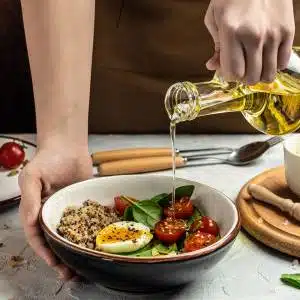“Good health begins with the right oil.”
In Indian kitchens, oil is not just a cooking ingredient. It affects how spices release their flavour, how food holds up to heat, and how nourishing each meal can be. The right oil adds depth to taste, balances texture, and supports overall well-being.
This guide explores the oils most suited for Indian cooking and helps you make a choice that works for both your food and your health.
Factors to Consider When Choosing an Oil for Indian Cooking
Choosing the best cooking oil in India can make the difference between a meal that is simply prepared and one that is both nutritious and flavourful. Here are the key factors to consider when selecting a cooking oil for Indian kitchens:
1. Fats
Oils are made up of different types of fats: saturated, monounsaturated, and polyunsaturated. Each type behaves differently under heat and has various implications for health. Saturated fats are more stable at high temperatures, making them suitable for frying, while unsaturated fats are considered healthier for the heart and can help maintain lower cholesterol levels. Understanding the fatty acid profile of an oil allows you to balance cooking performance and health benefits.
2. Nutritional Value
Oils carry more than just fat. Many provide vitamins, antioxidants (including oryzanol, carotenoids, phytosterols, and polyphenols), and essential micronutrients. For example, olive oil contains vitamin E and polyphenols, while mustard oil provides omega-3 fatty acids. Choosing oils with nutritional benefits can make everyday meals healthier without changing your cooking style.
3. Stability and Smoke Point
The smoke point is the temperature at which oil starts to degrade and release visible smoke. Some oils are more heat-stable than others. For frying or sautéing at high temperatures, it’s best to use oils that remain stable and do not smoke easily. Oils with lower smoke points are better suited for finishing dishes, making Indian snacks, or preparing salad dressings. Using the wrong oil for high heat can affect both flavour and safety.
4. Health Considerations
Not all oils are equally healthy. Highly processed or hydrogenated oils, which are chemically altered to stay solid at room temperature, can be harmful to heart health if consumed regularly. These oils often contain trans fats, which raise “bad” LDL cholesterol and increase the risk of heart disease.
On the other hand, natural cold-pressed oils retain most of their nutrients and beneficial compounds, making them a healthier choice. Consistently choosing oils that support heart health and provide antioxidants and essential micronutrients can have a long-term impact, especially in Indian cuisines, where oil is used generously.
By considering these factors, you can make smart choices that improve both the taste and the healthfulness of your Indian cooking.
Top Healthy Oils for Indian Cooking
If you’re wondering “Which oil is best for Indian cooking?”, Indians use a variety of oils at home, chosen for their nutritional benefits or cultural significance. Here are some of the best cooking oils in India for heart health and overall well-being.
1. Mustard Oil
Mustard oil is widely used in North and Eastern India for its pungent flavour. It has a good balance of monounsaturated and polyunsaturated fats and is rich in omega-3 fatty acids. It also contains erucic acid (a monounsaturated omega-9 fatty acid), which is generally safe in typical cooking amounts, though very high intake may be linked to heart issues. Mustard oil works well for frying and sautéing, but its strong aroma may not be suitable for all dishes.
2. Coconut Oil
Commonly used in South Indian and coastal cuisines, coconut oil adds a distinct flavour to curries and snacks. It is rich in saturated fats, which makes it stable for cooking at high temperatures. While it provides energy and a unique taste, it is best used in moderation for cardiovascular health.
3. Olive Oil
Olive oil is a versatile option that works well for both Indian cooking and raw preparations, such as salads and dressings. Rich in monounsaturated fats and antioxidants, it supports heart health and helps retain nutrients in food, making it a healthy choice for everyday use in Indian kitchens.
4. Sunflower Oil
Sunflower oil is light in flavour and suitable for deep frying and sautéing. It contains polyunsaturated fats and vitamin E, but its high content of omega-6 fatty acids means it should be used in moderation to maintain a balanced diet.
5. Groundnut (Peanut) Oil
Groundnut oil has a neutral flavour and a relatively high smoke point, making it suitable for frying and stir-frying. It is rich in monounsaturated fats, which may help reduce “bad” LDL cholesterol.
6. Sesame Oil
Sesame oil, especially unrefined or cold-pressed, adds a nutty aroma to Indian dishes. It contains polyunsaturated fats, antioxidants, and minerals. It works best for tempering, finishing dishes, or light sautéing, but is not suited for deep frying.
7. Clarified Butter (Ghee)
Ghee is a traditional staple in Indian cooking, valued for its rich flavour and ability to withstand high heat. It is high in saturated fats and contains fat-soluble vitamins. While it adds taste and texture to dishes, it should be used in moderation for heart-conscious cooking.
Why Olive Oil Is a Healthy Choice for Indian Cooking
Olive oil is best known in Mediterranean countries, but over time, it has found a place in many Indian homes as well. What makes it stand out is the kind of fat it contains. It is rich in monounsaturated fats, which help lower harmful cholesterol and support better heart health. This is especially important in India, where heart disease is becoming increasingly common.
Another reason olive oil is valued is its natural antioxidants, such as vitamin E and polyphenols. These nutrients help the body fight oxidative stress and inflammation, making the oil more than just a cooking medium. Used regularly, it adds an extra layer of nourishment to everyday meals.
Types of Olive Oil and Their Uses
| Type of Olive Oil | Notes | Best Suited For |
| Extra Virgin Olive Oil | Cold-pressed, rich in antioxidants and strong in flavour, best enjoyed raw or in low-heat cooking rather than deep frying. | Salad dressings, dips, and drizzling over cooked food |
| Pure Olive Oil | A blend of refined and virgin olive oil, it balances nutrition with higher heat tolerance. | Light sautéing, roasting, and everyday cooking |
| Extra Light Olive Oil | Mild in flavour and stable at high heat, it keeps its nutrition intact and adapts well to Indian cuisine | Frying pooris and pakoras, stir-frying, and baking |
Unlike many refined vegetable oils, olive oil keeps much of its natural goodness because it undergoes minimal processing. Extra-light olive oil, in particular, works well in Indian kitchens, where frying, sautéing, and other high-heat cooking methods are common.
Traditional oils, such as mustard, coconut, and ghee, will always have cultural and culinary importance. Olive oil is not a replacement for them, but it does offer a healthy and versatile alternative. By including it in rotation with other oils, families can enjoy familiar flavours while also supporting long-term well-being.
Tips for Using Olive Oil in Indian Cooking
- Choose the type of olive oil based on the dish. Extra virgin works best raw, pure olive oil suits light cooking, and extra light olive oil is good for frying.
- Combine olive oil with mustard, coconut, or groundnut oil to retain the traditional flavour profile and improve nutrition.
- Brush olive oil on rotis, parathas, or grilled vegetables instead of butter or ghee for a lighter touch.
- Stir in a spoonful of extra virgin olive oil into dal, khichdi, or soups just before serving to add richness and nutrients.
- Keep olive oil stored in a cool, dark place in a tightly closed bottle to maintain its freshness.
- Introduce it slowly into everyday cooking so the taste becomes familiar to everyone at home.
Takeaway
The oil you use influences both the taste and nutrition of your meals. Traditional choices like mustard, coconut, and ghee bring familiar flavours, while healthier options such as olive oil provide heart-friendly fats, antioxidants, and essential nutrients, allowing you to enjoy the benefits of olive oil alongside your favourite dishes. Using the right oil for each dish and being mindful of how you cook can help you prepare food that is both flavourful and better for your health.


